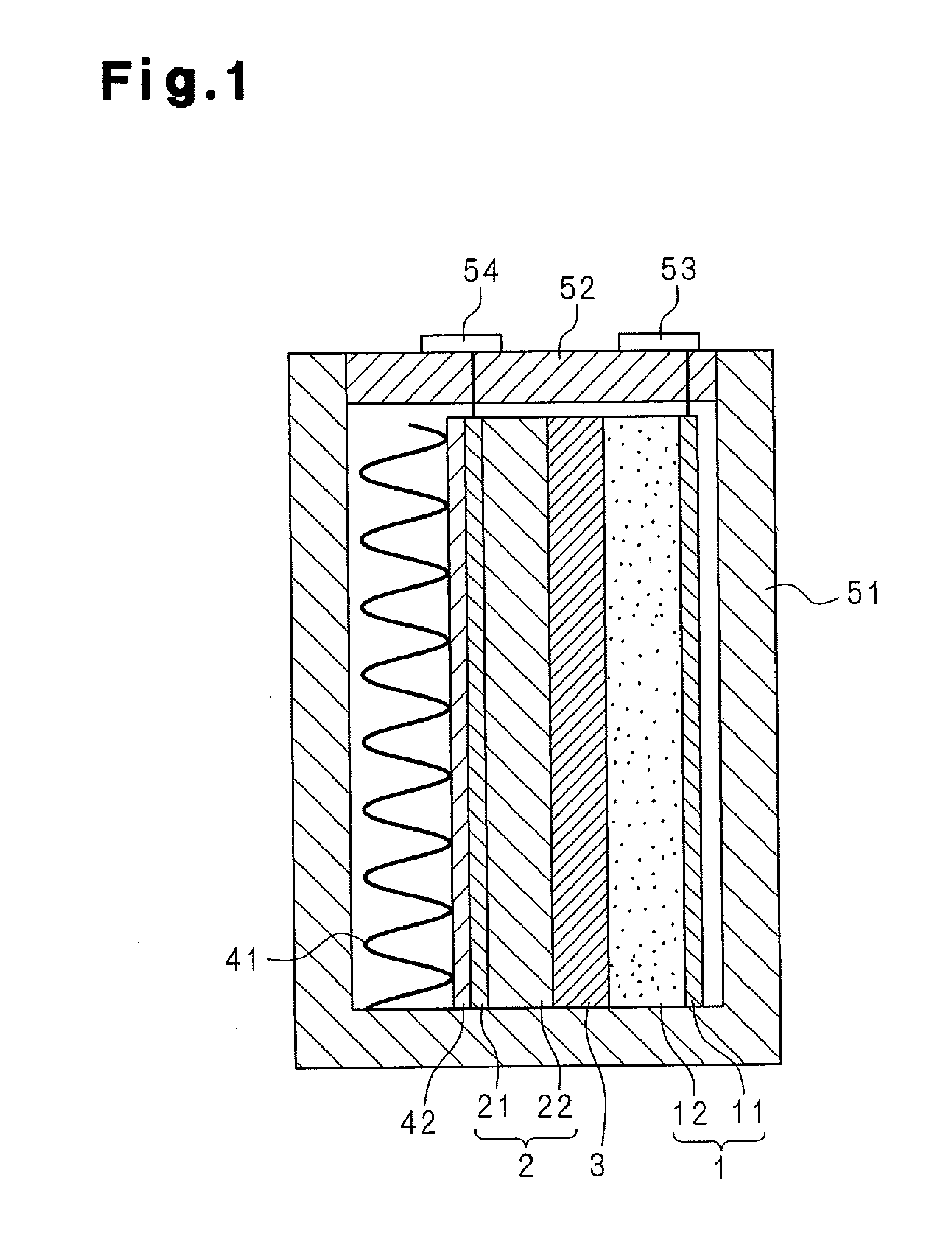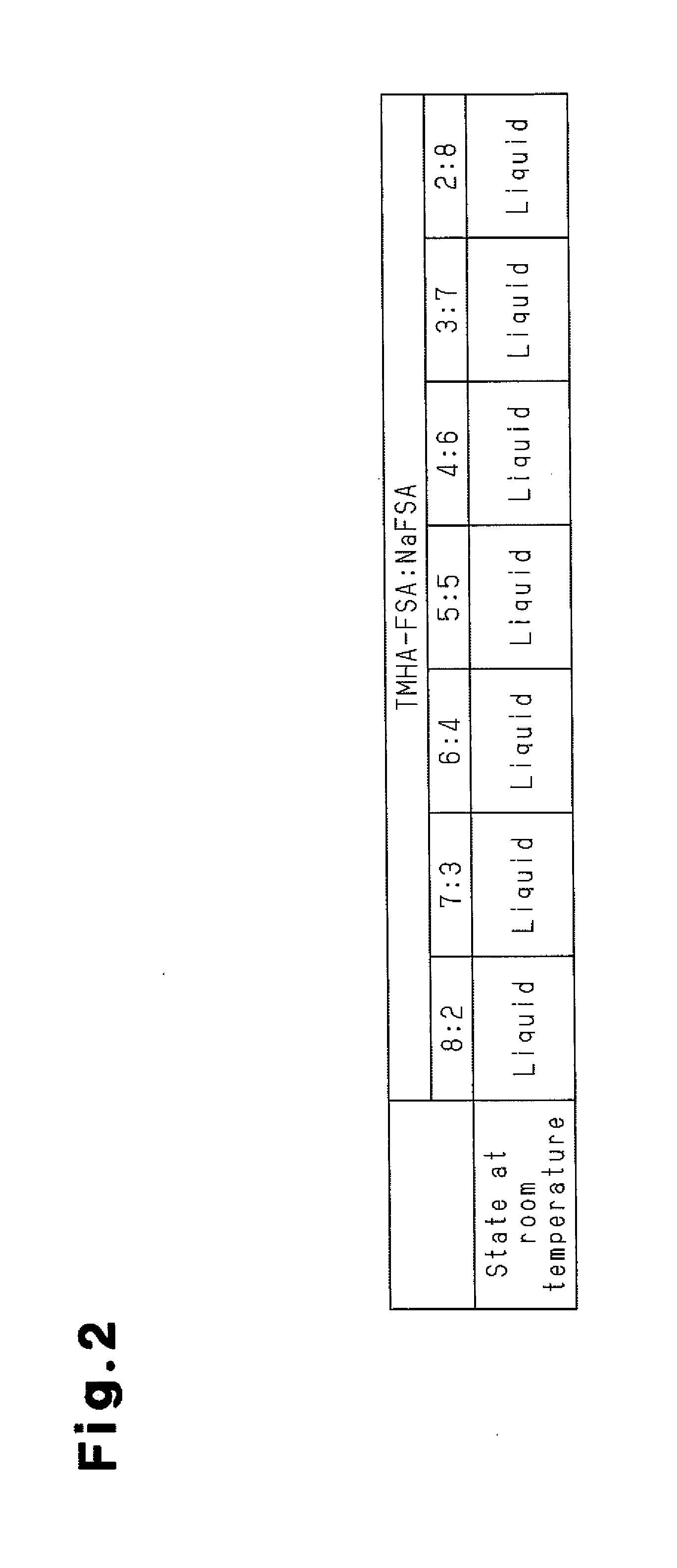Molten salt battery
a molten salt battery and molten salt technology, applied in the field can solve the problems of increased cost of molten salt batteries, and deterioration of the positive electrode, and achieve the effect of lowering the operating temperatur
- Summary
- Abstract
- Description
- Claims
- Application Information
AI Technical Summary
Benefits of technology
Problems solved by technology
Method used
Image
Examples
embodiments
[0052]Subsequently, embodiments will be more specifically explained with reference to the following first to fifth embodiments.
first embodiment
[0053]As a molten salt, a mixed salt of TMHA-FSA and NaFSA was prepared. Then states of the mixed salt at room temperature were investigated in relation to the molar ratios of the TMHA-FSA and the NaFSA in the mixed salt. First, a TMHA-Br produced by Wako Pure Chemical Industries, Ltd. and a KFSA produced by Mitsubishi Materials Electronic Chemicals Co., Ltd. were mixed in an equimolar ratio in water for preparing a TMHA-FSA. Then a resulting precipitate was filtrated and washed with water repeatedly several times. Subsequently, the TMHA-FSA was prepared by vacuum drying at 80° C. It should be noted that Br is bromine and K is potassium. The prepared TMHA-FSA and a NaFSA produced by Mitsubishi Materials Electronic Chemicals Co., Ltd. were mixed in various molar ratios in a glove box under an argon atmosphere to investigate its melting behavior at room temperature.
[0054]FIG. 2 is a table that represents molar ratios in the mixed salts of TMHA-FSA and NaFSA, and states of the mixed sa...
second embodiment
[0055]As a molten salt, a mixed salt of EMI-FSA and NaFSA was prepared. Then states of the mixed salt at room temperature were investigated in relation to the molar ratios of the EMI-FSA and the NaFSA in the mixed salt. The EMI-FSA was obtained from Tokyo Chemical Industry Co., Ltd. The EMI-FSA and a NaFSA produced by Mitsubishi Materials Electronic Chemicals Co., Ltd. were mixed in various molar ratios in the glove box under the argon atmosphere to investigate its melting behavior at room temperature.
[0056]FIG. 3 is a table that represents molar ratios in the mixed salts of EMI-FSA and NaFSA, and states of the mixed salts in each molar ratio at room temperature. As shown in FIG. 3, seven mixed salts that the molar ratios of the EMI-FSA and the NaFSA (EMI-FSA:NaFSA) were respectively 8:2, 7:3, 6:4, 5:5, 4:6, 3:7 and 2:8 were prepared. The mixed salts that the molar ratios were respectively 8:2 and 7:3 were liquid at room temperature. In addition, the mixed salts of other molar ratio...
PUM
 Login to View More
Login to View More Abstract
Description
Claims
Application Information
 Login to View More
Login to View More - R&D
- Intellectual Property
- Life Sciences
- Materials
- Tech Scout
- Unparalleled Data Quality
- Higher Quality Content
- 60% Fewer Hallucinations
Browse by: Latest US Patents, China's latest patents, Technical Efficacy Thesaurus, Application Domain, Technology Topic, Popular Technical Reports.
© 2025 PatSnap. All rights reserved.Legal|Privacy policy|Modern Slavery Act Transparency Statement|Sitemap|About US| Contact US: help@patsnap.com



